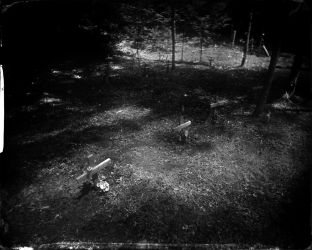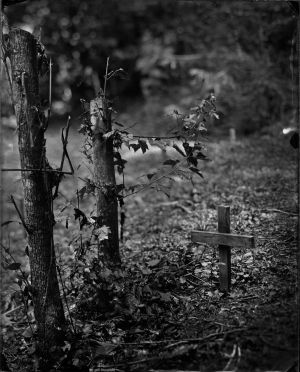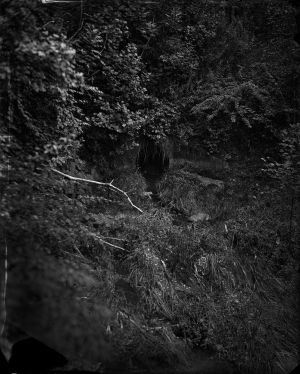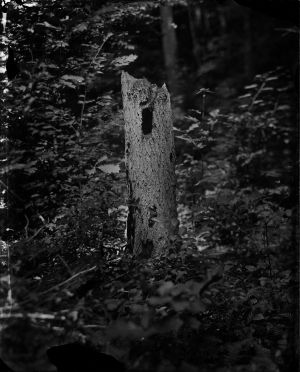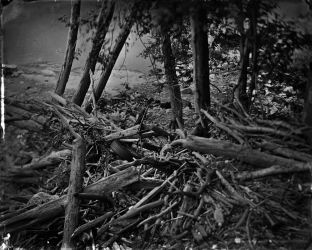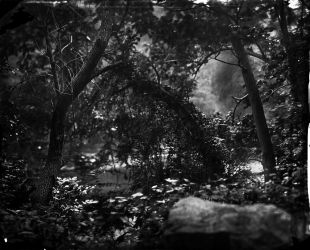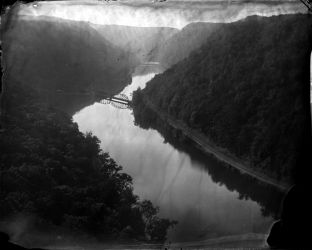A PHOTOGRAPHER’S DAYBOOK
By Lisa Elmaleh
July 2016, West Virginia
For our Fall 2016 issue, Catherine Venable Moore investigated the 1931 Hawk’s Nest Tunnel Disaster, which buried more than 700 workers in anonymity, many of them African-American; this event is still considered the worst industrial disaster in U.S. history. In our pages, the story was made all the more impactful by Lisa Elmaleh’s commissioned wet-plate collodion photographs. Here, Elmaleh shares additional photographs from her journey in West Virginia and her daybook from the trip.
DAY ONE
5 A.M. I wake up at home in Hampshire County and start driving in the still, quiet morning. I’m heading toward Fayette County in my faded red pickup with a loud, broken exhaust pipe. To the Hawk’s Nest Tunnel, it’s a four-hour drive, a pile of cassette tapes in my passenger seat, and a lot of coffee and cigarettes. My first day is scouting, finding the points on the map, seeking out the light.
12 P.M. Driving through Fayette County. The heat is immense, humidity thick. Evidence of flood damage, mud along the roads, furniture in ditches, high water lines on houses. The words TOTAL LOSS spray painted on a home brings me to tears. The devastation stays with me as I travel down the road.
3 P.M. I head over to the Sunoco station in Gauley Bridge. My air conditioner stopped working a few years ago, and I never fixed it. Today is the day that I regret not fixing it. My seat is soaked with sweat, and already I’ve drunk over a gallon of water. I buy a Coke and strike up a conversation with a friendly man named Larry. Larry says the thermometer on his home front porch read 106 when he left. I ask him if he knows where Vanetta is. “Vanetta!” he exclaims, “Why on earth would you want to know where that is?” I explain. “My parents were born and grew up in Vanetta,” he says. “I’ll be happy to take you there.” Tomorrow.
DAY TWO
5 A.M. I wake in Charleston, put on the stained clothes I wear to shoot in, my muddy boots, and sneak down the stairs, trying not to wake my hosts. When I reach the kitchen I realize they have already made me breakfast—eggs, bacon, toast, coffee—an early morning kindness which I don’t know how to thank them for. We sit at the table in the predawn hours, discussing my itinerary for the day.
6 A.M. The road toward Fayette County. In the rising light, I pass the landscape along 60, its hard poetry: vast silhouettes of mountains, gas stations soaked in fluorescent light, the town of Alloy’s warm glow, the kudzu-covered Alloy Mine Complex, the Kanawha River.
7 A.M. First stop: the Hawk’s Nest overlook. The dawn has no shadows. A thin fog hovers over the New River as I pull out my camera, an 8x10 wooden model with red bellows from the 1940s. I set up my darkroom and its chemicals and by the time I have my first plate coated, the fog has lifted, but the light is still hazy, almost iridescent.
9 A.M. An hour to the Whipporwill exit, at the Hawk’s Nest cemetery site. I set up my camera, large among the simple wooden crosses marking the graves. I set up my darkroom in the back of my truck under a shade tree. Like ravens, my chemical trays are balanced on rocks outside of the cemetery gate. I spend the entire morning here. The light is dappled and filtering through the trees, lending this moment a tenderness betrayed by the loud sound of the highway overhead, the putrid orange that runs as water in the creek nearby. Two FEMA workers stop by for a few minutes, say they are sightseeing but otherwise are not talkative. Larry had some hard words about FEMA, and I stare after their car as they drive away, wondering what their days consist of.
2 P.M. I stop at the U-SAVE Travel Plaza near Whippoorwill to buy a packet of tuna fish and crackers, a Coke. I scarf down the little lunch while sitting in the shade of the gas station’s roof. Then I fill up my gas tank, check my car’s oil, my darkroom’s silver levels.
4 P.M. The power station at Gauley Bridge. I park my truck in the parking lot above the station; the sign’s words, NO UNAUTHORIZED VEHICLES BEYOND THIS POINT, stop me. My darkroom is part of my truck: this means I won’t be able to get it close to where I want to photograph. I set up in the parking lot and then walk down, down, down toward the river, my heavy camera on its tripod and gripped to my body. I feel vulnerable: nobody knows I’m down here; the powerhouse is gushing, a strange mechanical noise over the rush of the river; the water pours out steadily; I’m far below the flood line. I crawl over debris from the flood: tires, branches, whole tree trunks, a propane tank. I set up my camera, find the image on the ground glass. I focus, wrap the camera in my darkcloth, then head full speed back uphill—it feels like hours to get back to my truck. I pull out a glass plate, pour the collodion on the surface, drop it into the silver bath. Three minutes of waiting, listening to the river below. I load the plate into my holder, head back downhill. I notice black clouds rolling in, hear thunder in the distance. I am racing against the impending storm, the clouds overhead blackening, worrying about what might happen in a flash flood down here. Thirty seconds of exposure in-camera, and back up the hill, back to my truck. I pull myself into my small cardboard darkroom, draping the light-tight fabric around me, and pour developer on my plate, making sure I can see shadow detail appear on the negatives, the small red lamp on my head revealing the exposure. I wash the plate in water, set it outside to wash, and coat up another plate with collodion for the next photograph. I drop it into the bath for another three minutes of waiting.
6:30 P.M. Larry meets me at the power station. The day approaches sunset. We are about forty-five minutes into a walk down the railroad tracks where Vanetta and Gamoca used to be. We pass a rattlesnake coiled up under the train tracks, startling Larry. Not many signs of life in these ghost towns; I’ll take the snake as a good omen. We reach Gamoca and he points to where the last house stood. It’s long since overgrown; big trees, thick brush block our view of where the foundation might be. We walk back. I make a picture on the tracks. Larry tells me about his children. The mountains and trees all around us go from lit to silhouette as the sky turns deep blue above us.
https://main.oxfordamerican.org/item/1054-a-photographer-s-daybook#sigProIdf33ba4f7dd
Enjoy this story? Find more of Lisa Elmaleh’s Hawk’s Nest photographs in Catherine Venable Moore’s “The Book of the Dead: In Fayette County, West Virginia, Expanding the Document of Disaster,” originally published in the Fall 2016 issue.



